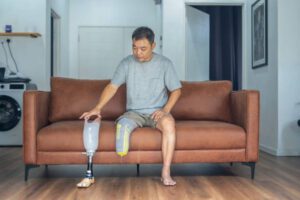Prosthetics and Amputation Technology Changing Lives

The field of prosthetics and amputation technology has undergone remarkable transformations over the years. From wooden limbs to high-tech mind-controlled prosthetics, the evolution is astounding. Today, we stand on the brink of even more groundbreaking changes. For amputees, medical professionals, and technology enthusiasts, understanding these advancements is crucial. This article explores the latest innovations, real-life stories, and future prospects in this dynamic field.
A Journey Through History
Amputation and prosthetics have been around for centuries. Ancient Egyptians were among the first to use wooden prosthetics. Fast-forward to the 16th century, French surgeon Ambroise Paré revolutionized prosthetic design with articulated limbs. Despite technological limitations, these early attempts laid the foundation for modern innovation.
The 20th century witnessed significant progress, especially after World Wars I and II. The demand for functional prosthetics surged, leading to the development of more sophisticated designs. By the late 1900s, lightweight materials like carbon fiber and plastics entered the scene, enhancing mobility and comfort for users.
Today, we benefit from a rich history of innovation. Understanding the past helps us appreciate the groundbreaking advances shaping the future of amputation technology and prosthetic advancements.
Advances in Amputation Techniques

Recent years have seen remarkable progress in amputation techniques. Targeted Muscle Reinnervation (TMR) and osseointegration are two cutting-edge methods revolutionizing the field.
TMR is a surgical procedure that connects nerves from an amputated limb to remaining muscles. This connection allows for more intuitive control of prosthetic devices. TMR not only enhances functionality but also reduces phantom limb pain, significantly improving the quality of life for amputees.
Osseointegration involves the direct attachment of a prosthetic device to the bone, offering greater stability and comfort. This technique eliminates the need for traditional sockets, reducing skin irritation and improving mobility. For many amputees, osseointegration represents a life-changing advancement in prosthetic technology.
Together, these techniques showcase the incredible potential of science and medicine in transforming the lives of amputees. They are paving the way for more personalized and effective solutions.
Exploring the Latest Prosthetic Technologies
Prosthetic technology is advancing rapidly, with innovations like myoelectric and mind-controlled prosthetics leading the charge. These cutting-edge technologies offer hope and possibility for amputees worldwide.
Myoelectric prosthetics use electrical signals from muscles to control prosthetic limbs. These devices provide a natural and responsive user experience, allowing for intricate movements and tasks. Users can grip objects, type on a keyboard, and perform everyday activities with remarkable ease.
Mind-controlled prosthetics take this a step further by using brain signals to control movements. These devices incorporate neural interfaces, translating thoughts into action. Though still in the experimental stage, mind-controlled prosthetics hold immense promise for the future of amputation technology.
These advancements are not just about function but integration into daily life. They are empowering individuals, offering newfound independence and confidence.
Stories of Transformation
Real-life stories highlight the profound impact of these technological advancements. For individuals like Sarah, a young athlete who lost her leg in an accident, myoelectric prosthetics have been a game-changer. With her new limb, she’s back on the track, pursuing her passion with vigor.
Then there’s Tom, a veteran who opted for osseointegration after years of struggling with socket discomfort. For Tom, the stability and comfort of his new prosthetic have made a world of difference. He’s now able to enjoy activities he once thought impossible.
These personal stories are a testament to the life-changing potential of modern prosthetic technology. They inspire hope and demonstrate the tangible benefits of innovation in the field.
The Future of Amputation and Prosthetic Technology
The future of prosthetic advancements looks promising, with developments like 3D printing and biotechnology on the horizon. These innovations are set to redefine what’s possible in the field.
3D printing allows for customized prosthetic designs, tailored to the unique needs of each individual. This technology reduces production time and costs, making high-quality prosthetics more accessible. Imagine a world where anyone can have a prosthetic limb precisely suited to their body and lifestyle.
Biotechnology is another exciting frontier, exploring ways to integrate living tissues with prosthetic devices. This could lead to prosthetics that feel and function like natural limbs, offering unprecedented levels of comfort and control.
The future holds boundless potential, driven by the continued pursuit of excellence in amputation technology and prosthetic advancements.
Practical Advice for Amputees
For amputees navigating the world of prosthetics, choosing the right device can be overwhelming. Here are some practical tips to guide the process.
First, consider your lifestyle and specific needs. Are you an active person who requires a durable and flexible limb? Or do you prioritize comfort and ease of use? Understanding your priorities will help you make an informed decision.
Next, consult with healthcare professionals and prosthetic specialists. They can provide valuable insights and recommendations based on your unique situation. Don’t hesitate to ask questions and seek second opinions if needed.
Finally, take your time to test different options. Prosthetics are a significant investment, and finding the right fit is crucial. Many providers offer trial periods, allowing you to experience the functionality and comfort of different devices.
With careful consideration and expert guidance, you can find a prosthetic solution that enhances your quality of life.
Impact on Lives and Healthcare
The advancements in amputation technology and prosthetics have far-reaching implications for both individuals and the healthcare industry.
For amputees, these innovations mean greater independence, improved mobility, and enhanced quality of life. They empower individuals to pursue their passions and engage fully with the world around them.
For healthcare providers, these technologies represent new opportunities for patient care. They enable more personalized treatment plans and open doors to new research and development possibilities.
The ongoing advancements in prosthetic technology continue to challenge the boundaries of what’s possible, offering hope and possibility to countless individuals worldwide.
Stay Informed and Engaged
The field of amputation technology and prosthetics is constantly evolving. Staying informed about the latest developments is crucial for amputees, medical professionals, and technology enthusiasts alike.
Consider joining online forums and communities dedicated to prosthetic advancements. Engaging with others who share similar experiences can provide support, inspiration, and valuable insights.
For those interested in further reading, numerous resources and publications explore the cutting-edge developments in the field. Staying informed ensures you’re equipped with the knowledge needed to make the best decisions for yourself or your patients.
The world of prosthetics is an exciting and rapidly advancing field. By staying engaged, you can be part of the ongoing conversation and contribute to shaping the future of prosthetic technology.

